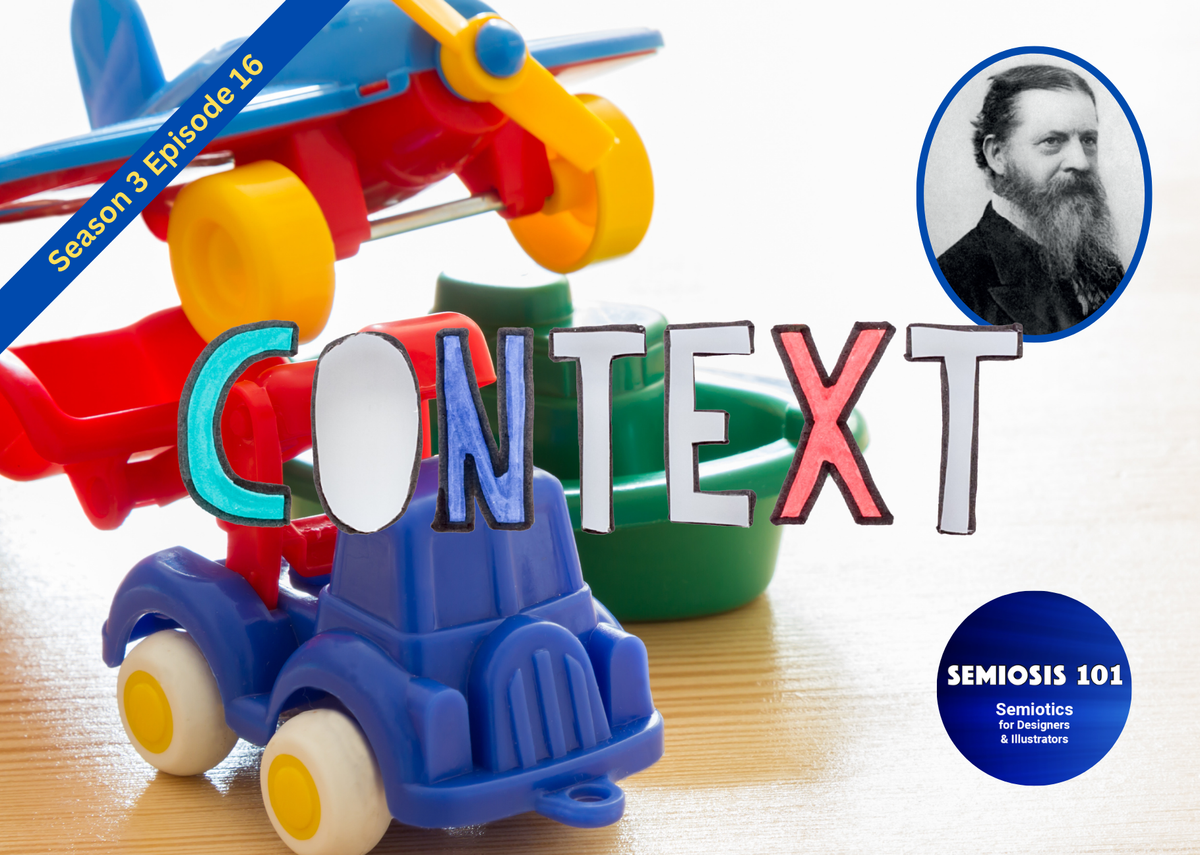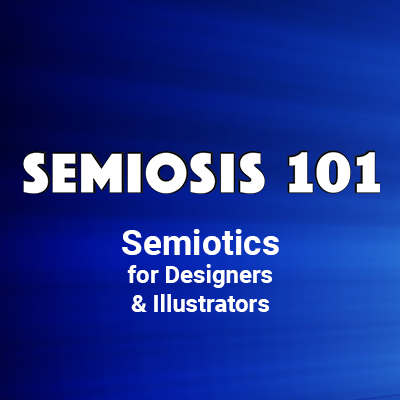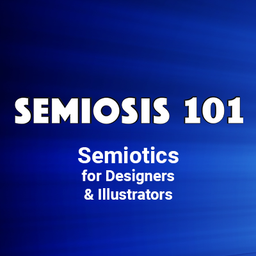Free Semiosis 101 Transcript 3.16:

SIGN-VEHICLES: Semiotically Getting Meaning Into the World
Hello readers.
In this free transcript for the episode published on Semiosis 101 on Weds 28 February 2024, will expand on what Peirce’s ten semiotic sign classes can mean within contemporary design or illustration practice. This will be delivered to you through three semiotic sign-vehicles.
Watch the free episode on YouTube for the full impact…
…and here is the episode’s transcript.
I ended the last episode on a designer-centric summary of the semiotic power combinations of Peirce ten sign classifications. I also answered the “so what?” question with an answer longer than a glib “because.” In this episode I will expand what the ten sign classes can mean within contemporary design or illustration practice. I will deliver this through three sign-vehicles.
Brumm Brummm. Rev up… Hit subscribe to this YouTube channel, and I will explain…
In episode 3.15 I concluded with a designer-centric summary of each of Peirce’s ten semiotic sign classifications power levels. These ten power summaries were…
|
ONE: |
possible > |
familiar > |
instant |
|
TWO: |
possible > |
familiar > |
mediated |
|
THREE: |
possible > |
existent > |
mediated |
|
FOUR: |
suggested > |
existent > |
mediated |
|
FIVE: |
possible > |
familiar > |
agreed |
|
SIX: |
possible > |
existent > |
agreed |
|
SEVEN: |
suggested > |
existent > |
agreed |
|
EIGHT: |
possible > |
proxy > |
agreed |
|
NINE: |
suggested > |
proxy > |
agreed |
|
TEN: |
resolved > |
proxy > |
agreed |
Great! Jobs-a-good’un! That is surely that then?
No this is just my current attempt at putting Peirce’s obtuse terminology into language useful to creatives. This is not my first attempt, or the only attempt out there to explain Peirce’s ten signs. In his 2017 book FireSigns – A Semiotic Theory for Graphic Design, Steven Skaggs also has made inroads, and in my 2016 PhD appendix so did I. Back in 2014-16 I found that I could not side-step these ten semiotic sign classes, and pretend they had no impact beyond an interesting philosophical thought-exercise.
My whole PhD practical component was constructed around Sign Four, which in turn nested Signs Two and Three. Peirce referred to Sign Four as a “any concept [Object] of direct experience, in so far as it is a sign, and, as such, affords information concerning its concept [Object].” In Peirce’s precise terminology Sign Four is a…
Dicent Indexical Sinsign (suggested > existent > mediated)
…can you see why I have attempted to reframe these terms into actionable analogues?
If we focus on the final word in the set of three, we see the delivery method - the sign-vehicle. This is what we will focus on this episode when delving into the ten sign classes. Back in 2014, three years before FireSigns was published, I was a fairly lone voice in seeking a more designer-centric explanation of Peirce’s ten classifications. The closest explanation of the classifications using visual examples was an academic paper from 2009 by two Taiwanese information scientists, Andrea Huang and Tyng-Ruey Chuang called Social Tagging, Online Communication, and Peircean Semiotics: A Conceptual Framework.
So in this episode, I will synthesise ten designer-centric explanations for each sign class’s delivery from synthesised examples from my PhD and Skaggs’ FireSigns book. In doing so, I will also focus on how each sign-vehicle semiotically gets meaning into the world. Peirce’s names for the delivery are Qualisign, Sinsign and Legisign, but on Semiosis 101 I have translated these into designer-centric terms as instant, mediated and agreed.
Back in episode 3.6 I introduced Sign One. Peirce calls this a Rhematic Iconic Qualisign, but I have defined it in a Top Trumps way as having the semiotic power of possible > familiar > instant. Sign One is an ephemeral sign class of a quality on the edge of perception, which has possibility for a visual but weak meaning-bearing instantaneous connection with the target audience. But it is fleeting, and it triggers familiarity which aids semiotically grabbing attention without any determining representation. Skaggs gives an example of “graphic elements that are composed to form larger, complex displays.”
The delivery of any meaning the quality may suggest is an instant perceptual “hit.” Or not. As the only ephemeral sign-vehicle in the ten classes, a Qualisign can only be instantly perceived as meaning-bearing before the next sign class takes over.
The next three sign classes have mediated delivery of meaning. Peirce calls this a Sinsign. Peirce’s Sign Two utilises Sign Ones to mediate its visual meaning-bearing existence. I agree with Skaggs who discusses this class in the context of “image,” and refers to all “instances of depiction.” Perceived as an instance of meaning-bearing, its delivery is through visual mediation that is a one-off presentation depicting possible familiar qualities (Sign Ones) of the concept, in a deliberately crafted represented form (Sign Two).
Sign Three can only exist as a possibility of being interpreted as the concept, through a mediated existent likeness to it. The audience’s attention to the interpretation is facilitated by nesting Sign Twos within Sign Three. Once the Sign Two has grabbed the attention, Sign Three’s possible relations to the concept can be perceived and interpreted.
The last of the mediated delivery sign classes is Sign Four. Peirce’s famous example for this sign class is a weathercock representing the concept ‘wind.’ Wind is mediated through interpreting the existent suggested direction the weathercock turns and points. It is a sign class of direct experience and nests the two previous classes. Nested Sign Twos mediate the delivery of the familiar qualities of the concept, while the nested Sign Three provide possible existent things to frame the experience. Sign Four then builds on this mediation to visually suggest the experience. Skaggs gives an example of a franked postage stamp as evidence of the act of postage. The stamp design asserts nothing, but the franking of the stamp asserts the experience.
The next six sign classes all fall within an agreed sign-vehicle class which Peirce calls a Legisign. In the next episode we will go into more depth with these six sign classes. But as this episode concerns itself with the sign-vehicle delivery, we will just focus on that in more depth now. Peirce names the delivery of these six sign classes as Legisigns (Legi as in a “law”). It is easier to think of this delivery method as agreed. Three classes that have this agreed delivery have perception semiotic power levels of possible, two have suggested levels and Sign Ten’s Perception Power is at a resolved level. Moving to the semiotic Communication Power level, Sign Five’s level is familiar, while Six and Seven have existent representation levels. Sign classes Eight to Ten can be described as having proxy representation levels.
Okay, this IS sounding like a game of Top Trumps now! What on Earth does any of that have to do with illustrators or designers?
Think about your audience. They are not blanks. They have experiences that they bring to anything visual, which will frame THEIR ability to interpret. At the highest semiotic sign class, Sign Ten can be described as resolved | proxy | agreed. Peirce obtusely calls this sign an Argument Symbolic Legisign. So let me unpack this sign class to contextualise it to contemporary visual communicators.
At this level of semiotic sign, its representation needs to be general enough (proxy) to ensure as many audience members will understand it. The concept it is indicating must generally be known and understood by as many as possible too (resolved). To ensure the audience reaches and accepts the intended meaning, the delivery of it leads them to an interpretation that is generally agreeable.
Within Visual Communication Design, Sign Tens form signage, branding, etc. anything that needs its visual language to communicate on a general level to many audience members. Sign Ten is a bit of a visual communication holy grail, as there can be many socio-cultural and linguistic incompatibilities, which can become semiotic noise, interfering with its success. But there are successful visual examples.
Republic of Ireland-based graphic designer Juan Solis has researched the humble signage for gendered toilet facilities around the world. This piece of ubiquitous signage utilises an agreed method by using proxy representations for male and female bodies, to resolve how to indicate in non-verbal ways which toilet to use. But Skaggs in FireSigns reminds creatives that “no graphic display (…) has the power on its own terns” to be conclusive. But we can use Semiosis to improve our chances.
The focus on agreement in the case of sign classes Five to Ten, as a semiotic delivery method, makes you creatives consider what the audience already know, and how you can encode for that to improve the opportunities to visually connect with as many people as possible. In sign classes Two to Four, the delivery method acknowledges that the level below agreement has to be built on successful mediation. After all, to accept a general agreement that this IS that the audience has to be visually guided to that interpretation. Before mediation or agreement that this IS that the audience’s attention has to be hooked and maintained. So ephemeral semiotic qualities are employed to instantaneously hook the audience.
I will caveat the terms I have defined as still in a process of evolution. Can you suggest more apt terms?
Semiosis 101 Semiotic Design Resources is a reader-supported publication. To receive exclusive posts and support my work, consider becoming a free or paid subscriber. Paid subscribers get name checked on all future Semiosis 101 YouTube episodes.
===Semiosis 101 Patreon Producer==============
Become a Semiosis 101 Patreon Producer and get a named producer credit on future video episodes, plus watch all new episodes months ahead of YouTube.
===Semiosis 101 Patreon Exclusives==============
Watch longer Patreon-exclusive Semiosis 101 episodes on applying Semiosis into design and illustration…
PATEXC001 How does semiotics work in illustration?





